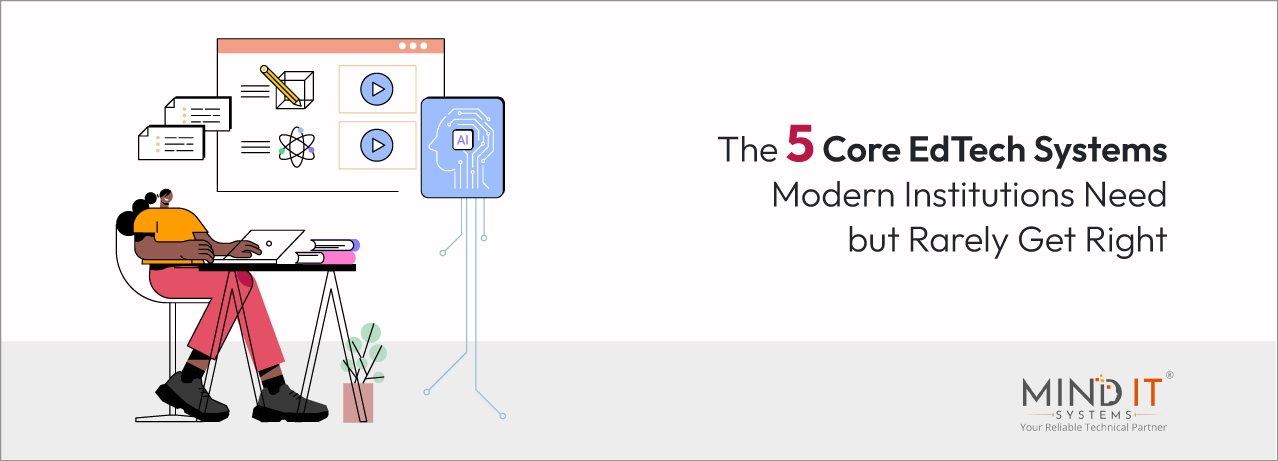
Despite EdTech’s projected market value of $348.41 billion by 2030, many educational institutions still face digital fatigue, fragmented systems, and underused platforms.
After working closely with leaders across K–12 and higher education, a clear pattern continues to emerge: while schools invest heavily in technology, the promised transformation often falls short. This is where experienced education tech companies can make a measurable difference by aligning tools with institutional goals.
Modernization isn’t just about adopting new tools—it’s about implementing the right systems with intention, aligned with both strategy and people.
Let’s explore the five foundational EdTech systems every modern institution must get right to move from digital overload to meaningful impact.
5 Core EdTech Systems Every Institution Needs to Get Right
Get these five right, and your digital investments will finally start delivering real returns.
1. Learning Management Systems: Making EdTech Work for Engagement
The Learning Management System (LMS) should be the heart of digital learning. Yet for many institutions, it ends up as nothing more than a document storage system.
According to Fortune Business Insights, the global LMS market is expected to surpass $70 billion by 2030, driven by demand for personalized and adaptive learning.
Where institutions go wrong:
- Poor integration with other education tools
- Limited use of adaptive learning features
- Clunky interfaces that disengage faculty and students
A high-impact LMS should:
- Personalize content based on performance data
- Integrate seamlessly with your SIS and analytics tools
- Be accessible across devices and bandwidths
If you’re considering modernizing your LMS, strategic IT consulting can help you align technology choices with your long-term educational goals. Partnering with expert education tech companies ensures your LMS becomes a dynamic learning engine, not just another system to manage.
Pro tip: If your LMS isn’t driving learner engagement, it’s just digital clutter. Focus on personalization and seamless integration; your LMS should feel like an intuitive extension of daily learning, not an obstacle course.
Let’s identify the gaps and build a roadmap to elevate your EdTech strategy with clarity and confidence.
2. Student Information Systems: Aligning Education Technology and Data
Your Student Information System (SIS) is more than just digital attendance—it’s the institution’s data brain.
A connected SIS empowers educators to make data-informed decisions and adapt swiftly to student needs.
Why it matters:
- Disconnected data causes confusion and delays
- A unified SIS supports strategic planning and reporting
- Real-time insights drive student-centric actions
Key features to look for:
- Secure, role-based access controls
- Integrations with HR, finance, and LMS tools
- Custom workflows that fit your academic model
Understanding why is digital transformation strategy essential for businesses can inspire institutions to treat SIS modernization as a mission-critical priority rather than a routine upgrade. The most effective education tech companies build SIS platforms that unify data and support real-time decisions.
Pro tip: A strategic SIS isn’t just a tool; it’s the foundation of institutional agility. Make sure it can grow and adapt as your data and reporting needs evolve.
3. Campus Systems: Powering Non-Academic Operations
Operations outside the classroom are just as critical. Yet, many institutions still rely on manual processes for admissions, housing, library systems, and other functions.
According to Gartner, fewer than 25% of institutions use centralized campus platforms.
What happens when systems are siloed:
- Delays in communication
- Inefficient workflows
- Frustration among parents, staff, and students
A smart campus management system should offer:
- Mobile dashboards for staff and students
- Automated workflows (fees, transport, room booking)
- Unified integration with SIS and communication tools
When evaluating campus platforms, consider choosing the right outsourcing partner for software development needs. Reputable education tech companies bring a holistic approach to building these platforms with security, scalability, and user-centricity in mind.
Pro tip: True digital transformation includes operational excellence. Centralize workflows, reduce friction, and design every process around a smooth experience for staff, parents, and students.
Discover how a digital first approach can cut complexity and deliver real results. Let’s explore your EdTech transformation together.
4. Assessment Platforms: Data-Driven Learning at Scale
Assessments should be more than marks—they’re learning tools.
A strong assessment and analytics platform enables personalized learning, identifies risks early, and drives better teaching strategies.
McKinsey reports that data-informed institutions are 23% more likely to improve student outcomes.
Benefits include:
- Adaptive assessments tailored to learning pace
- Predictive alerts for at-risk learners
- Actionable dashboards for instructors
Incorporating a digital first approach into assessment platforms enables institutions to respond faster to learner needs and deliver truly personalized learning technology. Many top education tech companies now integrate AI and analytics to enhance these platforms’ effectiveness.
Pro tip: Don’t just track scores, use real-time analytics to intervene early, tailor content, and empower instructors to drive measurable improvements in outcomes.
5. Engagement Tools: Building Connected Institutions
Communication gaps are silent killers in educational environments.
Strong engagement platforms are the glue that holds your EdTech ecosystem together, boosting trust, clarity, and satisfaction.
What great platforms do:
- Offer multichannel communication (email, app, SMS, portal)
- Use chatbots and AI assistants to deliver 24/7 answers, automate reminders, and gather feedback
- Provide real-time updates for parents and students
- Support community engagement through polls and surveys
Real-world stat: A recent EdSurge study shows that adopting centralized engagement tools can boost parent satisfaction by up to 30%.
Pro tip: Engagement isn’t optional; it’s your institution’s credibility engine. A smart blend of technology in education, like AI-powered chatbots and human support, is what sets future-ready institutions apart.
Ready to move beyond disconnected tools? Get a customized roadmap to unify your systems and drive lasting impact across your institution.
Why Institutions Still Struggle with EdTech?
With increasing budgets and new tools, why do many institutions still struggle to keep pace?
Because they:
- Deploy tech without an integration roadmap
- Prioritize features over user needs
- Treat rollout as a checklist, not a cultural shift
EdTech isn’t about buying tools. It’s about building connections between people, data, and purpose. Leading education tech companies know that thoughtful implementation and cultural alignment are just as important as the technology itself.
Building a Future-Ready EdTech Ecosystem: Your 5-Point Plan
- Audit your tools – Identify where data and user journeys break down
- Map integrations – Make sure platforms talk to each other
- Tailor workflows – Customize to match your institution’s goals
- Train teams early – Bring staff onboard from day one
- Track real KPIs – Look beyond logins; measure impact, feedback, and engagement
Next Step Toward Smarter EdTech Decisions
EdTech success isn’t measured by how much technology you adopt, but by how well it serves your people. Systems alone don’t transform institutions—insightful implementation does.
When your tools support teaching, learning, and operations in harmony, the real magic happens: less complexity, more clarity, and stronger outcomes.
Because the smartest institutions aren’t just using technology, they’re using it with intention.
If this sparked questions about your approach to EdTech, we’re just an email away, info@minditsystems.com. Schedule a free consultation to explore what your institution may be missing and discover how to effectively bridge the gaps.
Frequently Asked Questions on Education Technology
1. What is the most critical EdTech system for schools to prioritize?
Ans. The Learning Management System (LMS) is key—it anchors digital instruction and student engagement. It also connects seamlessly with assessments, analytics, and communication tools when implemented well.
2. How can institutions avoid digital fatigue when implementing EdTech?
Ans. Start with clear goals and integrated platforms that serve real user needs. Avoid piling on tools—focus on adoption, training, and system alignment.
3. What’s the ROI of investing in campus automation tools?
Ans. Automation reduces manual workloads and boosts operational efficiency across departments. It leads to faster service delivery, cost savings, and improved satisfaction.
4. How do EdTech systems support personalized learning?
Ans. They use real-time data and adaptive algorithms to tailor learning to individual needs. This helps educators deliver timely interventions and improve outcomes.
5. How do we choose the right education tech partner?
Ans. Choose education tech companies with proven experience, strong integration capabilities, and a focus on user-centric design. Look for those with a proven track record, and reliable post-launch support.
Share this post
About the Author

Sujoy Roy
(Head – Digital Marketing)
From my teenage time, I had a quench to solve problems and loved leadership. Starting my career in relation management, ignited my passion for managing people. While managing I realized technology needs to be incorporated to keep pace with the changing world & do my work efficiently.

